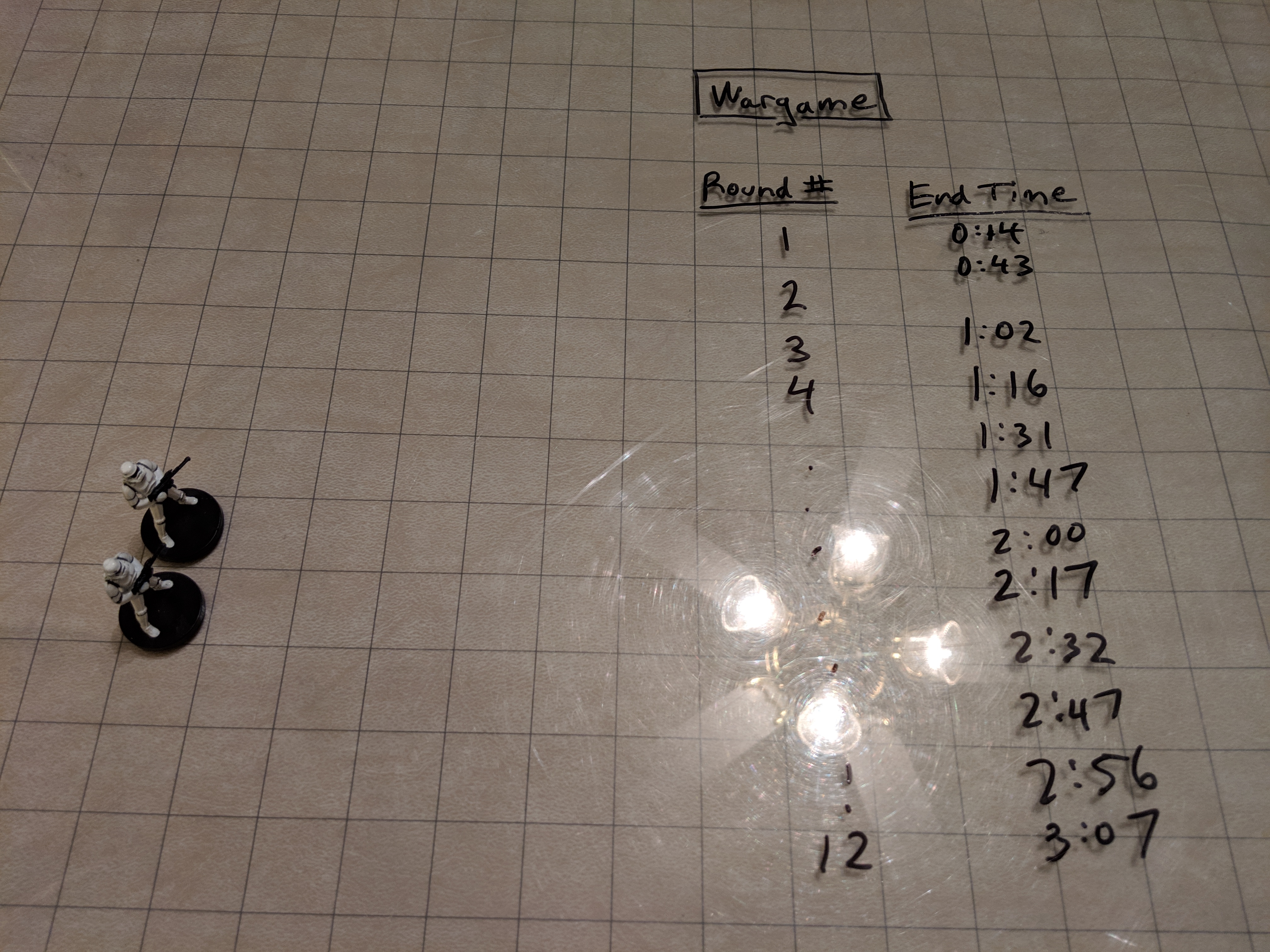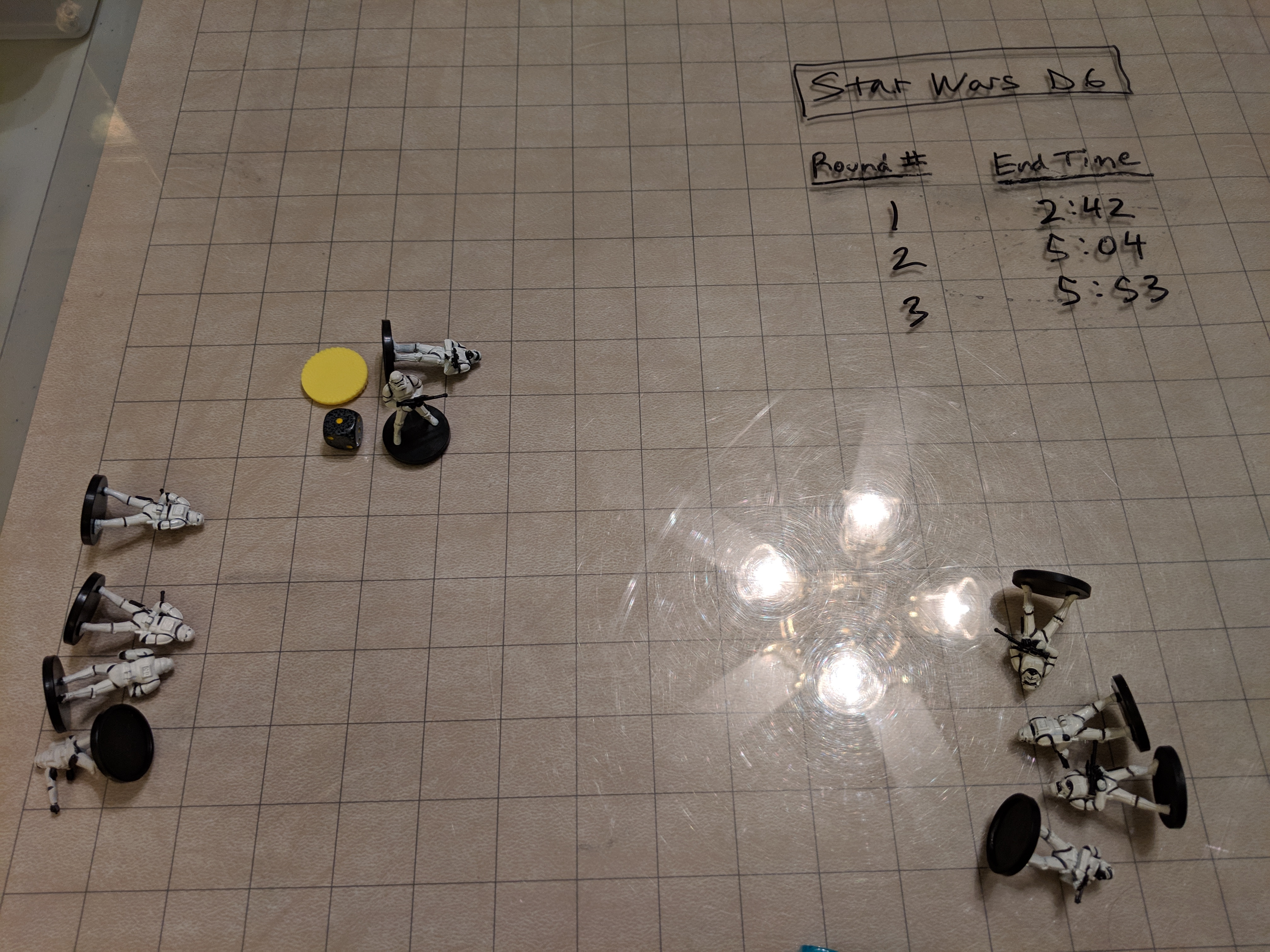I wanted to get a sense of the relative speed to run combat when using Traveller 2e, Star Wars: The Roleplaying Game 1e (the West End Games d6 version), and my own mass-combat wargame rules based on One Page Rules. Here are the results, along with my rules cheat sheet I used when running the mock combat.
The Setup
There are 5 Star Wars Stormtroopers firing at 5 Rebel agents who were discovered undercover, disguised in Stormtrooper armor. Both sides use identical stats.
Units don’t move, take cover, or do anything special (for example, characters don’t take reactions such as Dodge). It’s just a Napoleonic-era style division line fighting.
In the two RPGs, untill two opponents are down, fire at person across from you (or 1st person to your left if the person across from you is down). After two opponents are taken out, focus fire on the most wounded opponent. Combat continues until one side is eliminated.
After each round I stop to stap a picture of the end of round status.
Actual combat in a real RPG game would take longer than any of these simulations of course since there is table banter, people moving minis around, rules discussions, and so forth, so these numbers only give a relative sense of combat time.
The Results
One Page Rules Combat
[su_box title=”Wargame Stat Block” style=”default” box_color=”#8ff2ff” title_color=”#000000″ radius=”3″]
STORMTROOPER SQUAD [5]: Quality 5+, Defense 5+, Attacks: Assault Rifles (24”, A1), CCWs (A1)
[/su_box]
Combat Rules Summary
Attack: Roll d6s for each model to hit.
Damage: d6’s for each model to defend. 5’s or better hit, and 5’s or better defend. Hit models are removed from combat.

Wargame Combat Results
Star Wars d6 Combat
[su_box title=”d6 Stat Block” style=”default” box_color=”#8ff2ff” title_color=”#000000″ radius=”3″]
Imperial Stormtrooper: All stats are 2D except: blaster 4D, brawling parry 4D, dodge 4D, brawling 3D. Stormtrooper Armor: adds +1D to Strength code for damage purposes only. Reduces Dexterity code and all Dexterity related skills by 1D. Stormtrooper Weapons: Blaster pistol (damage 4D), blaster rifle (damage 5D).
[/su_box]
Combat Rules Summary
Attack: Blaster Rifle (5D to hit, TN 10 (for short range))
Damage: 5D damage – 3D Strength/Armor soak
Wound Resolution
Wound Taken: by comparison of rolls; Damage roll’s multiple of Strength+Armor.
- DR<SR = Stunned (Prone, -1D per stunned level, if >= STR (2) unconscious, wears off end of creature’s next turn).
Marked by [su_label type=”default”]Green Chips[/su_label] - DR>SR = Wounded (Prone, -1D till healed, can’t act this round).
Marked by [su_label type=”warning”]1 Yellow Chip[/su_label] - DR>2xSR = Incapacitated (Prone, out of combat).
Marked by [su_label type=”success”]1 Red Chip[/su_label] - DR>3xSR = Mortally Wounded (Prone, out of combat).
Marked by [su_label type=”success”]2 Red Chips[/su_label]
Model Down = prone.
Prone Characters: +2 target number to hit , -1D on skill checks, costs an action (at -1D) to rise from prone. You can always fall prone without penalty at the end of your movement.
House Rule: A Strength to resist damage roll must be at least double the damage roll to completely soak it, so just beating the damage roll (but less than double) is still a stun (for normal damage). (this is from the 1e Rules Companion)
Combat Rules Outcome

d6 Combat Results
Traveller Combat
[su_box title=”Traveller Stat Block” style=”default” box_color=”#8ff2ff” title_color=”#000000″ radius=”3″]
Imperial Stormtrooper 7773C8 Age 22 1 term Cr12,000
Skills: Rifle-2, SMG-2
Gear: Blaster Rifle 3D, Stormtrooper Armor +8 Protection
[/su_box]
Combat Rules Summary
Attack: Blaster Rifle (+2 to hit, TN 8)
Damage: 3D damage – 8 Armor soak.
Wound Resolution
After 14 points of damage the character is out of combat.
- 1-6 Hits
Marked by [su_label type=”default”]Green d6[/su_label] - 7-12 Hits
Marked by [su_label type=”warning”]Yellow d6[/su_label] - 13+ Hits
Marked by [su_label type=”success”]Red d6[/su_label]
Combat Rules Outcome

Traveller Combat Results
Tracking Conditions in Star Wars d6
After running the simulated combat here’s what I am thinking about tracking damage in Star Wars:
Initial Thinking
- Prone — Lay the model down on the table to indicate they are prone / crawling.
- Shaken (1 Green Poker Chip) — The condition of ‘you can’t act’ we will call ‘Shaken’. We will house rule Shaken to clear at the end of the creatures next turn (as opposed to ‘can’t act this round or next’).
- Stunned (1+ Yellow Poker Chips) — We track stunned with Yellow Poker Chips. You can have multiple Stunned tokens. Stunned effect clears at the end of the creatures next turn.
- Wounded (1 Red Poker Chip) — We track stunned with a Red Poker Chip. Note that you can’t clear this condition during combat.
- Incapacitated (1 Black Token) — Usually you remove incapacitated enemy NPCs or creatures from the board, but if you want to keep them on the board (for example, you want to keep the opponent alive and need to know how bad they’re hit) you can keep them on the board with one Black Token.
- Mortally Wounded (2 Black Tokens) — Like incapacitated, but with 2 Black Tokens.
- Dodge — We don’t track creatures doing a Dodge with Tokens. Instead, players track when their character does a Dodge and alerts the GM when it impacts combat. The GM tracks NPCs doing a Dodge. Usually, only important named NPCs would do a Dodge action.
After this initial post I came up with another way to track damage
- Prone — Lay the model down on the table to indicate they are prone / crawling.
- Stunned (1+ Green Poker Chips) — We track stunned with Green Poker Chips. You can have multiple Stunned tokens. Stunned effect clears at the end of the creatures next turn.
- Wounded & Can’t Act (2 Yellow Poker Chips) — We track Wounded and Can’t Act with a Yellow Poker Chip. Note that you can’t clear wounded condition during combat, but the Can’t Act clears at the end of the character’s next turn.
- Wounded & Can Act (1 Yellow Poker Chip) — We track Wounded with a Yellow Poker Chip. Note that you can’t clear this condition during combat.
- Incapacitated (1 Red Chip) — Usually you remove incapacitated enemy NPCs or creatures from the board, but if you want to keep them on the board (for example, you want to keep the opponent alive and need to know how bad they’re hit) you can keep them on the board with one Black Token.
- Mortally Wounded (2 Red Chips) — Like incapacitated, but with 2 Red Chips.
- Dodge — Dodge action is tracked using special acrylic Dodge tokens.
Also consider using Litko tokens such as these:
Analysis
Here are the key metrics from the simulation:
Wargame
- 12 combat rounds
- Total Time 3:07 minutes = (3*60)+7 = 187 seconds
- Average Round = 16 seconds
- Average Time Between Player Dice Rolls = 8 seconds
Star Wars d6
- 3 combat rounds
- Total Time 5:53 minutes = (5*60)+53 = 353 seconds
- Average Round = 118 seconds
- Average Time Between Player Dice Rolls = 59 seconds
Traveller
- 6 combat rounds
- Total Time 11:52 minutes = (11*60)+52 = 712 seconds
- Average Round = 119 seconds
- Average Time Between Player Dice Rolls = 119 seconds
Insights
OPR Wargame rules are 4x Faster than Traveller — The One Page Rules wargame system is about 4 times faster than Traveller combat. So you can run a mass combat that would take 2 hours in only 30 minutes when using OPR wargame rules.
Star Wars Combat is as Fast or Faster Than Traveller — Star Wars d6 combat resolved in half the time the same combat took to resolve in Traveller. Part of this I think is Traveller armor provides serious protection, whereas the Stormtrooper armor I think was a bit nerfed. If you increased the Strength and/or Armor of Star Wars combatants, I think it would take longer to resolve. This was surprising to me; I assumed that the different wound levels would increase combat time. Aside from this though, it seemed it was easier to hit opponents in Star Wars d6, making me think that surprising opponents and taking cover is a big deal, maybe even more impactful than in Traveller.
d6 Math is Simple and Fast — Star Wars d6 flowed much more smoothly than I expected. I was thinking it would feel more like Savage Worlds. What I noted was that (like Traveller) dice selection was fast (everything is a d6, unlike Savage Worlds or D&D). In Star Wars d6, most math is addition, with the only other math the quick multiplication of comparing Damage to Strength. It’s pretty simple to eyeball a number and say “is my Damage double the Strength roll?” You don’t even have to do the math — I can quickly decide 13 Damage is higher than but not double a Strength roll of 11 even without doing the multiplication. So in most cases you’re just adding dice scores together. Thinks like Armor let you add or subtract dice from the dice pool which is easier than math (this reminded me of Cortex, where physically adding and subtracting dice is done before the roll, making things easier). Compare this to Star Wars d6 2e or Savage Worlds where you take the results and do division on it to determine wounds. Even Traveller feels a bit more complicated — you’re subtracting 8 from the skill check to determine the Effect, and then subtracting Armor from the Damage result. Star Wars d6 notion of ‘add, compare’ feels simpler and faster than Traveller’s ‘add, subtract, add, subtract’ or Savage Worlds ‘add, explode, add, divide, compare’.
Traveller is More Predictable — Star Wars feels more ‘swingy’ than Traveller and its harder (for me anyway) to eyeball and determine likely outcomes. Traveller is more consistent (target number is always 8) and damage and the outcome of battles seems more even and predictable.
Damage Tracking Using Tokens in Star Wars is Smooth — Damage tracking was simpler in Star Wars than I was expecting when using Tokens. For Traveller, I use d6s which take a second to flip around to find the right set of pips on the die. Colored tokens in Star Wars can be placed under the mini and take less space on the battlemat. Unlike Savage Worlds, there is no ‘unshake’ option, so (aside from Stunned tokens), wounds, once received, stay with you. So combat is fast, and there is not a lot of extra dice rolls or fiddling with tokens to unshake or remove tokens.



Recent Comments